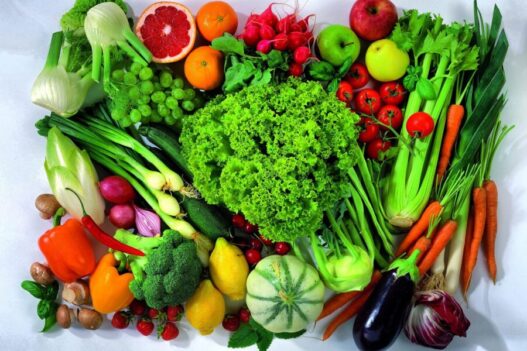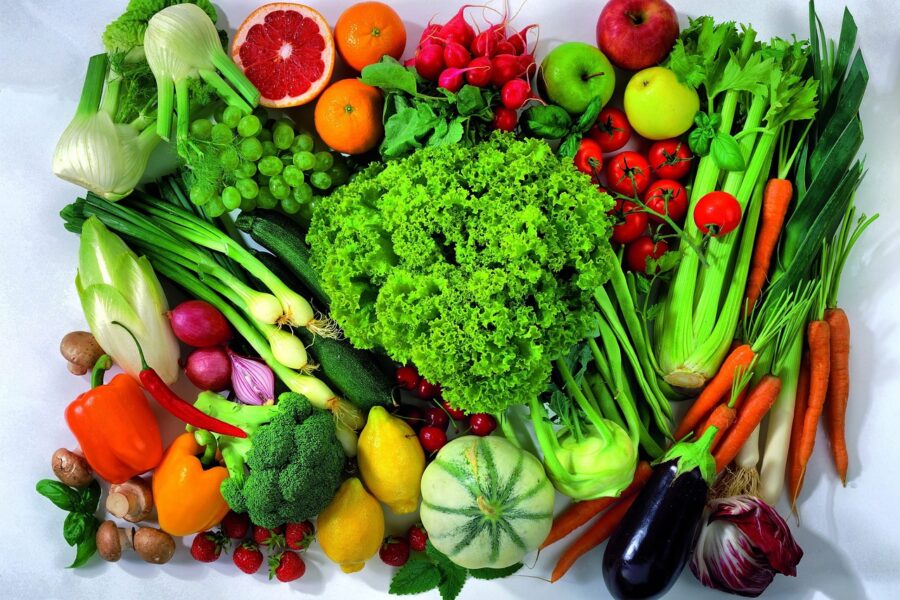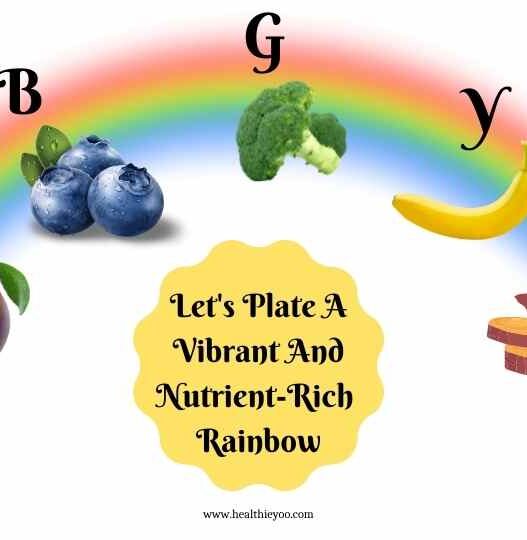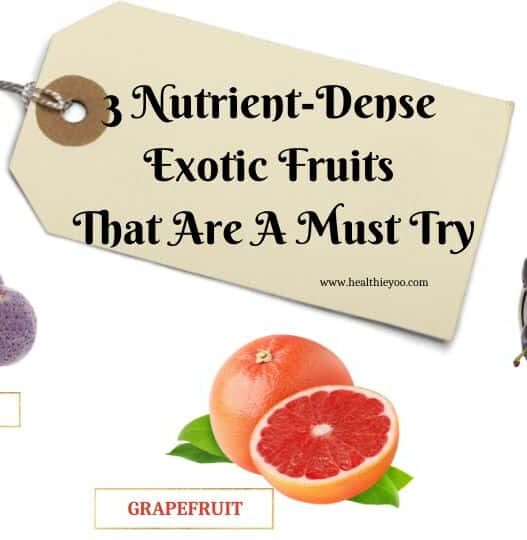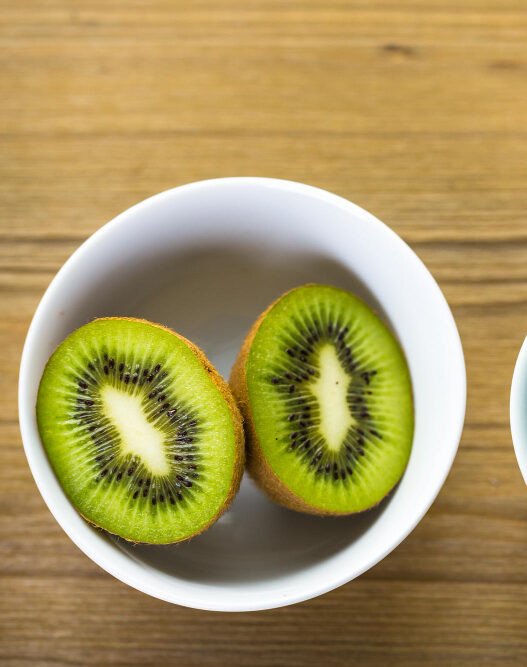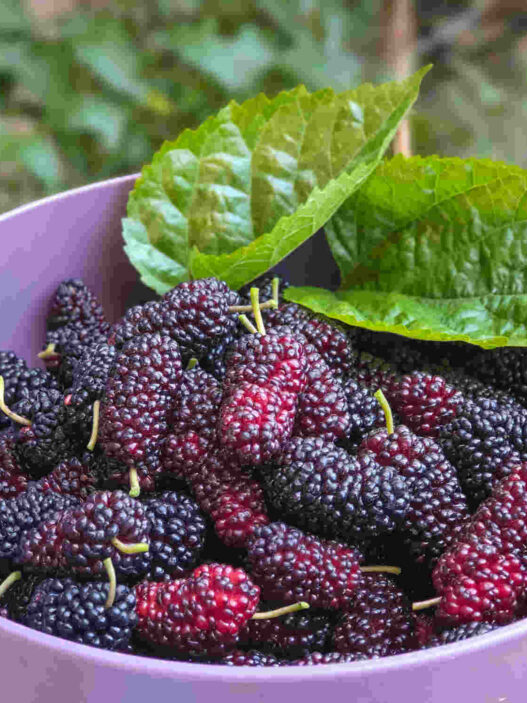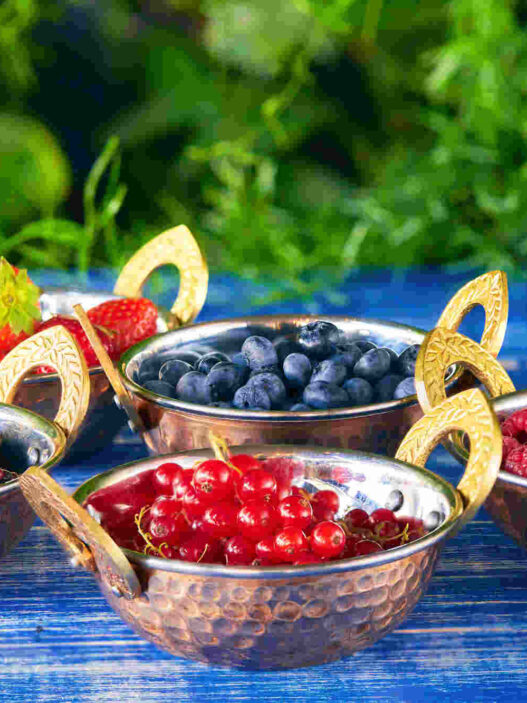A healthy diet should include plenty of fresh fruits and vegetables. They are high in important vitamins, minerals, fiber, and other nutrients for overall health. Studies have shown that eating a balanced diet rich in fruits and vegetables can help prevent cancer and other chronic diseases due to their nutrients. Fresh fruits and vegetables are high in micronutrients and macronutrients. Below are the functions of important nutrients in fruits and vegetables and their daily recommendations.
Minerals (such as iron and calcium) and vitamins (such as vitamin C, folic acid, B complex vitamins, and carotenoids) make up the micronutrients, while complex carbohydrates/fibre make up the macronutrients.
Fruits and vegetables are high in iron, calcium, vitamin C, folic acid, carotenoids (vitamin A precursors), and phytochemicals. Some vegetables and fruits are low in calories, and others, such as potato, sweet potato, tapioca, and yam, as well as fruits like banana, are high in starch, which provides a good source of energy. As a result, we can employ vegetables and fruits to raise or decrease the number of calories in our diet.
WHAT FUNCTIONS DO THESE NUTRIENTS AND SPECIAL FACTORS IN FRUITS AND VEGETABLES PERFORM IN OUR BODIES?
IRON
Iron is one of the important nutrients present in certain vegetables. Iron is a crucial component for the synthesis of haemoglobin, the red pigment found in red blood cells. Haemoglobin is a protein that aids in the delivery of oxygen to tissues.
Anaemia is a disorder marked by paleness, easy weariness, and increased susceptibility to infections caused by a decrease in haemoglobin in the blood.
Iron can be found in abundance in green leafy plants. However, iron absorption is limited. To enhance iron absorption, vitamin C-rich meals must be consumed on a daily basis.
VITAMIN A
This fat-soluble vitamin is required for clear eyesight in low light and the maintenance of epithelial tissue integrity. The white of the eye (conjunctiva) loses its shine and becomes dry when vitamin A insufficiency occurs. The black portion of the eye (cornea) necroes in severe vitamin A deficiency, resulting in irreversible blindness in young infants.
Vitamin A is also important for maintaining the body’s resilience to common illnesses. Thus, Vitamin A is one of the important nutrients present in several fruits and vegetables. Green leafy vegetables, carrots, tomatoes, sweet potatoes, papaya, mango, and other fruits and vegetables that are green or deep yellow/orange in colour are high in carotenoids.
VITAMIN C
Vitamin C is an important component for strong bones and teeth. It also aids in the absorption of iron. Weakness, bleeding gums, and poor bone growth are all symptoms of vitamin C insufficiency.
Fresh amla, citrus fruits, guava, banana, and certain vegetables, such as tomatoes, are high in vitamin C. It is, nevertheless, extremely vulnerable to air oxidation. As a result, most of the vitamin C originally present in vegetables is lost when they become dry and stale, or when they are chopped and exposed to air.
DIETARY FIBER
Dietary fibre slows the passage of food through the intestines. Dietary fibre is necessary for normal bowel function and the prevention of chronic constipation, diverticular disease, haemorrhoids, coronary heart disease, diabetes, and obesity.
Dietary fibre also lowers cholesterol levels in the blood. Dietary fibre has long been recognized as a preventive factor against colon cancer. Thus, dietary fibre, one of the important nutrients in fruits and vegetables, must be consumed for your health.
ANTIOXIDANTS
The importance of vegetables and fruits as antioxidant sources has received a lot of attention in recent years. Antioxidants protect the cell and its components from the harmful effects of reactive oxygen free radicals.
Antioxidants have a high biological value in terms of protecting against certain diseases. Atherosclerosis, cancer, inflammatory joint diseases, asthma, diabetes, and other diseases are all caused by harmful free radical reactions.
Antioxidants can be found in raw and fresh foods such as green leafy vegetables, carrots, and fresh fruits such as citrus and tomatoes. Vitamin C and carotenoids, both of which are found in these plants, are potent antioxidants.
Orange vegetables contain beta-carotene, red vegetables have lycopene, deep red vegetables contain beta lines, and blue and purple vegetables contain anthocyanins. These are some of the important nutrients in fruits and vegetables.
KEY NUTRIENTS FOUND IN FRUITS AND VEGETABLES
Nutrient | Health Benefit | Found In |
|
Vitamin A |
Healthy eyes and skin; protects from infection |
Apricots, Cabbage, Cantaloupe, Carrots, Grapefruit, Greens, Leaf and Romaine Lettuce, Mangos, Spinach, Sweet Potatoes, Tomatoes, Watermelon |
|
Vitamin C |
Healthy teeth and gums; helps heal cuts and wounds |
Bell Peppers, Broccoli, Brussels Sprouts, Cabbage, Cantaloupe, Cauliflower, Grapefruit, Oranges, Pineapple, Strawberries, Tomatoes |
|
Calcium |
Healthy teeth and bones |
Greens, Kale, Okra, Rhubarb, Spinach |
|
Fiber |
Healthy digestive system; Reduced risk of heart disease |
Apples, Bananas, Beans, Broccoli, Brussels Sprouts, Lentils, Peaches, Pears, Raspberries, Spinach |
|
Folate |
Wound healing; normal cell division |
Asparagus, Broccoli, Peas, Beans, Greens, Spinach, Strawberries |
|
Iron |
Healthy blood; learning ability |
Beans, Lentils, Spinach |
|
Magnesium |
Healthy bones |
Beans, Spinach |
|
Potassium |
Healthy blood pressure |
Bananas, Beans, Broccoli, Potatoes, Sweet Potatoes, Tomatoes |
HOW MANY FRUITS AND VEGETABLES SHOULD WE CONSUME DAILY FOR THE NUTRIENTS PRESENT IN THEM?
Taking into account the nutrient requirements, the Expert Committee of the Indian Council of Medical Research has suggested that everyone consume at least 300 g of vegetables per day (GLV: 50 g; Other vegetables: 200 g; Roots & Tubers: 50 g). Fresh fruits (100 g) should also be consumed on a daily basis.
Pregnant women should take 100 g of leafy vegetables per day since their iron and folic acid requirements are increased.
Overweight/obese people should avoid high-calorie veggies and fruits.
DAILY RECOMMENDATIONS FOR FRUITS FOR THE NUTRIENTS PRESENT IN THEM
|
Toddlers |
12 to 23 months |
½ to 1 cup |
|
Children |
2-4 yrs |
1 to 1½ cups |
|
5-8 yrs |
1 to 2 cups | |
|
Girls |
9-13 yrs |
1½ to 2 cups |
|
14-18 yrs |
1½ to 2 cups | |
|
Boys |
9-13 yrs |
1½ to 2 cups |
|
14-18 yrs |
2 to 2½ cups | |
|
Women |
19-30 yrs |
1½ to 2 cups |
|
31-59 yrs |
1½ to 2 cups | |
|
60+ yrs |
1½ to 2 cups | |
|
Men |
19-30 yrs |
2 to 2½ cups |
|
31-59 yrs |
2 to 2½ cups | |
|
60+ yrs |
2 cups |
SOURCE – https://www.myplate.gov/eat-healthy/fruits
DAILY RECOMMENDATIONS FOR VEGETABLES FOR THE NUTRIENTS PRESENT IN THEM
|
Toddlers |
12 to 23 months |
⅔ to 1 cup |
|
Children |
2-4 yrs |
1 to 2 cups |
|
5-8 yrs |
1½ to 2½ cups | |
|
Girls |
9-13 yrs |
1½ to 3 cups |
|
14-18 yrs |
2½ to 3 cups | |
|
Boys |
9-13 yrs |
2 to 3½ cups |
|
14-18 yrs |
2½ to 4 cups | |
|
Women |
19-30 yrs |
2½ to 3 cups |
|
31-59 yrs |
2 to 3 cups | |
|
60+ yrs |
2 to 3 cups | |
|
Men |
19-30 yrs |
3 to 4 cups |
|
31-59 yrs |
3 to 4 cups | |
|
60+ yrs |
2½ to 3½ cups |
SOURCE – https://www.myplate.gov/eat-healthy/vegetables
COLOURS OF FRUITS AND VEGETABLES AND THE NUTRIENTS
Eating a wide variety of fruits and vegetables will provide you with the most health advantages and illness protection. Adults should consume at least five types of vegetables and two types of fruit every day, according to the National Health and Medical Research Council (NHMRC) of Australia’s dietary guidelines.
To gain the full spectrum of health advantages, try to eat a rainbow of bright fruits and vegetables every day.
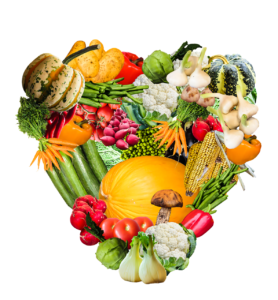
Consider the following scenario:
- Tomatoes and watermelon are examples of red cuisine. These have lycopene in them, which is regarded to be beneficial in the fight against prostate cancer and heart disease.
- Spinach and kale are examples of green veggies. These are high in lutein and zeaxanthin, which may help prevent age-related macular degeneration.
- Blue and purple fruits and vegetables, such as blueberries and eggplant. These include anthocyanins, which may aid in cancer prevention.
- Cauliflower, for example, is a white food. These contain sulforaphane, which may help prevent cancer in some people.
NUTRIENTS IN FRUITS AND VEGETABLES AND PREVENTION OF DISEASES
Phytochemicals, or plant compounds, are found in fruits and vegetables. These biologically active substances may help to prevent the development of certain diseases.
According to scientific evidence, eating a lot of fruits and vegetables on a regular basis lowers your risk of:
- Type 2 Diabetes
- Stroke
- When fruits and vegetables are eaten as food rather than supplements, heart (cardiovascular) disease is reduced.
- Cancer – some types of cancer that develop later in life.
- Blood pressure that is too high (hypertension).
NUTRITIONAL COMPOSITION FOR COMMON FRUITS AND VEGETABLES
FOOD NAME |
PROTEIN |
FAT |
CARBOHYDRATE |
ENERGY |
|
Amaranth |
3.29 |
0.65 |
2.28 |
128 |
|
Cabbage |
1.58 |
0.13 |
2.36 |
75 |
|
Lettuce |
1.54 |
0.27 |
3.01 |
91 |
|
Parsley |
5.55 |
1.14 |
1.05 |
18 |
|
Spinach |
2.14 |
0.64 |
2.05 |
102 |
|
Capsicum |
1.11 |
0.34 |
1.84 |
68 |
|
Cauliflower |
2.15 |
0.44 |
2.03 |
96 |
|
Cucumber |
0.71 |
0.16 |
3.48 |
82 |
|
Ladies finger |
2.08 |
0.22 |
1.59 |
115 |
|
Tomato |
1.12 |
0.27 |
3.18 |
87 |
|
Apple |
0.29 |
0.64 |
13.1 |
261 |
|
Banana |
1.25 |
0.32 |
24.95 |
463 |
|
Dates |
2.45 |
0.35 |
74.91 |
1340 |
|
Lemon |
0.41 |
0.75 |
6.97 |
153 |
|
Orange |
0.70 |
0.13 |
7.62 |
156 |
|
Papaya |
0.42 |
0.6 |
14.61 |
100 |
|
Pineapple |
0.52 |
0.16 |
9.42 |
180 |
|
Pomegranate |
1.33 |
0.15 |
0.57 |
11.58 |
|
Watermelon |
0.59 |
0.16 |
3.02 |
70 |
For all the fruits and vegetables refer to the source – http://www.eeb.cornell.edu/biogeo/nanc/Food_Feed/table%201%20gopalan%20et%20al%201989.pdf.
CONCLUSION
Consume as many fruits and vegetables as possible on a regular basis for the nutrients present in them. Consume a variety of veggies and fruits (curry, soups, mixed with curd, added to pulse preparations and rice). Salads with raw and fresh vegetables and fruits should be consumed. If at all possible, grow the family’s vegetable needs in the kitchen garden. Green leafy veggies are healthy when properly washed and prepared.
Allow various fruits and vegetables to provide colour to your dish and vigour to your life. Foods high in beta-carotene, such as dark green-, yellow-, and orange-coloured vegetables and fruits, help to prevent vitamin A insufficiency. On the go, eat healthily. In many nations, there has been a rapid improvement in nutrition education trends, and the majority of programmes have been successful in raising fruit and vegetable consumption. Health providers should employ several interventions to give information in several smaller doses throughout time to achieve better outcomes.

Prachi Vora is a graduate student pursuing BSc Hons in Food Science and Nutrition Management from JDBI Institute affiliated to Jadavpur University, Kolkata. She wrote this article as an in-house Intern writer at Healthieyoo.
